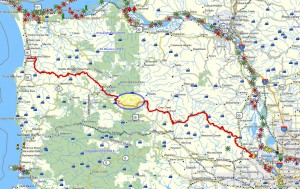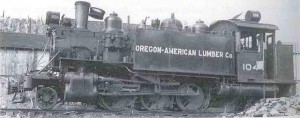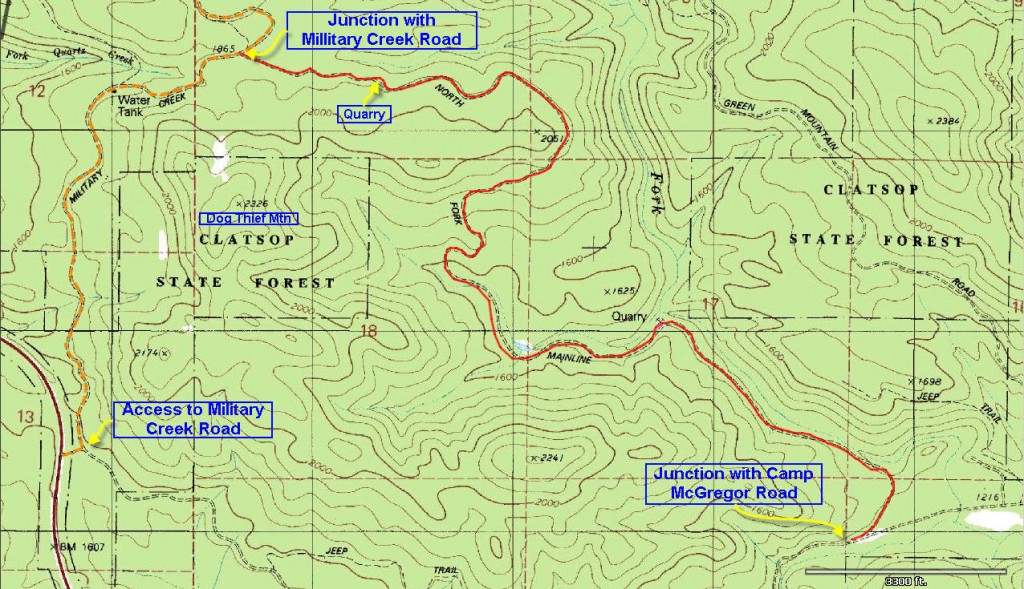 Brief description: This trail segment linking Camp McGregor road to the Military Creek Road is located about half way to the coast on the northern route. It is accessible from the Rock Creek Mainline Road that turns off from US 26 just west of the Sunset Highway Rest Area.
Brief description: This trail segment linking Camp McGregor road to the Military Creek Road is located about half way to the coast on the northern route. It is accessible from the Rock Creek Mainline Road that turns off from US 26 just west of the Sunset Highway Rest Area.
Distance: 4 miles to the junction with the Military Creek Road.
Walk duration: 1.5 hours
Travel time to trail head: 56 minutes (45.5 miles) from the Sylvan interchange on Highway 26 to the gate at the base of the Rock Creek Mainline (the logging road leading to Camp McGregor). The entrance to the Rock Creek Mainline is variably open and closed throughout the seasons.
Elevation change: 1430′ in elevation at the base of the North Fork Rock creek road; elevation at the junction with Military Creek is 1920′ in elevation. Total elevation gain is 490′
Trail Log:
This segment of the “Northern Route” starts at the junction of the Rock Creek Mainline road and the North Fork Mainline road situated about 2.5 miles north of the yellow gate that periodically closes this road to the public trying to enter from US 26.
At the entrance a sign announces the area as the Camp McGregor Tree Farm – owned by Stimson Lumber Company. It is also apparently under the jurisdiction of the North Coast Travel Management area that affects the regulations affecting the hunting of big game – according to the signage. I suspect that the one form of travel not covered by these regulations is bi-pedal, or walking!
From the gate it’s about two and a half miles to the base of the North Fork Mainline road – the first of several that branch off to the left and climb into the Dog Thief Mountain and Green Mountain areas. The Rock Creek Mainline used to be an important arterial for the Oregon-American Lumber Company that conveyed lumber from the heart of the Wolf Creek area down into Vernonia. Camp Olsen, the most remote camp was reserved fro the “bachelors” It was located above the North Fork of the Salmonberry River, just south of what is now US 26. Somewhat closer to Vernonia was Camp McGregor the Oregon-American Lumber Company’s main logging camp, where the married lumber men lived with their wives. Camp McGregor was named after W.H. McGregor; it was constructed in 1922 and abandoned in 1957.
 Old timers recall how every morning the #105 Oregon-American steam engine would pull 26 empty log cars up the valley from Vernonia. Just beyond Keasey they would cross “Deadman’s Bridge” and then they’d have to build up enough steam to make it up the grade to Camp McGregor. Later in the day, engineer Chet Alexander and fireman “Boomer” Reynolds would return hauling the 26 loads of logs down the Rock Creek corridor. After dumping them them into the mill pond in Vernonia, they would overnight in Vernonia and repeat the operation the next day. This continued: five days a week, one trainload a day for 33 years (except during the war when they pulled two trainloads out every day).
Old timers recall how every morning the #105 Oregon-American steam engine would pull 26 empty log cars up the valley from Vernonia. Just beyond Keasey they would cross “Deadman’s Bridge” and then they’d have to build up enough steam to make it up the grade to Camp McGregor. Later in the day, engineer Chet Alexander and fireman “Boomer” Reynolds would return hauling the 26 loads of logs down the Rock Creek corridor. After dumping them them into the mill pond in Vernonia, they would overnight in Vernonia and repeat the operation the next day. This continued: five days a week, one trainload a day for 33 years (except during the war when they pulled two trainloads out every day).
The Wolf Creek Fire
The great Tillamook Burn of 1933 has received a lot of attention, but it is often forgotten that during that same year another fire, the Wolf Creek Fire burned a total of 47,000 acres of timber and reduced Camp McGregor to a heap of smoldering ashes. It is thought that the fire broke out in some unburned slashing on the East-side Logging Company property in the late afternoon of August 24th, 1933. Men and equipment were rushed by train from Vernonia to the scene, but a rapid change of wind direction and an increasing velocity of wind soon caused the fire to jump beyond the firefighter’s lines. The wind rising to gale proportions soon whipped the inferno into a frenzy. During the late afternoon of August 26th, the wind suddenly reversed direction and began to blow at near-hurricane strength – directly threatening Cam McGregor itself. The firefighters rallied and initially thought that they could save the community, but the force of the wind and the fire that it drove before it was unstoppable – especially after a fallen snag broke the pipeline that supplied water to the community.
Judd Greenman recalled the scene in the book, The Oregon -American Lumber Company: Ain’t no more, “this fire crowned whole sections of timber; it spotted ahead as much as two miles at one jump and it burned downhill and against the wind, so you know it did an enormous amount of damage. We never had a chance. Ten thousand of the best men that ever wore calks could never have done as we did – stood and watched her go.”
One 17 year boy recounted how he was forced to snatch 2 mattresses from the bunkhouses and after quickly soaking them in the pond, he lay sandwiched between them while the fire raged over him.
As the authorities realized that saving the Camp was hopeless they ordered the residents and the CCC crews to evacuate by train. But the CCC boys, being mostly from urban eastern locales, panicked and tried to force the families off the train until it was made clear that there was room enough for everyone. Within one hour the entire Camp was engulfed in flames and burned to the ground – the walkways that connected the houses caught fire like a fuse leading the conflagration from one cabin to the next! The fires didn’t burn out until September 5th when the rains finally arrived.
Today, the Camp McGregor road is a bucolic stretch of road, but we will take the first left hand road leading up into the hills, the so-called North Fork Mainline road. This road initially heads in a northerly direction, but it shortly turns west and climbs up a small valley gaining about 263 feet in elevation over the next mile. At the top of this valley the road turns left and crests the shoulder of the mountain at an elevation of 1497 ft.
Over the next mile the trail curves southward and climbs about 100 ft. in elevation – passing a defunct quarry and a small pond. Eventually the road turns westwards and about 2 miles into the hike the road begins to climb again. Over the next 2/3 mile the road ascends the eastern face of Dogthief Mountain, climbing from about 1600 ft. in elevation to over 1940 ft. in elevation. As it reaches the top of this remote peak it turns left (southwards) and begins to traverse the western face of this mountain. Here the route is pretty level, rising and falling a mere 40-50 feet. Finally, when we are about 3.5 miles into the hike the route dips down to meet the military Creek road at an elevation of 1897 ft. In all the hike is about 4 miles long – one way.


I just read you story about the Wolf Creek fire at Camp McGregor. My Grandfather was a logger there . I have a few old photos of him standing with some of the other loggers on the felled trees. My gradfather and grandmother raised there two sons from birth there. My father who died 4 yrs ago recalled living at camp McGregor as one of the highlights in his life. I was never told about the Wolf creek fire having burned Camp McGregor down to the ground . Thank you for writing about this. My kids and grandkids will love to hear what happened to the place that my family called home. Do you know of any other books or sorces of old photos that we could find more detailed history . We are doing our family research and would love to put the dates that my family was living there in the history. Thank you . Karen
Dear Karen:
There are some books out there, most recently a book was written by Paul Michael Clock (author of Punk, Rotten and Nasty) about the RR company that operated just to the east of Camp McGregor. I have yet to track him down, but this upcoming book should be very relevant to your family history.
Jim Thayer
Thank you so very Much Jim. I will look for the book. I sure wish my dad was still alive so that he could enjoy the new book that is coming out. I,ll be looking for it. I will be happy to post a few of the old photos that I have of Camp McGregor if you think any one would be interested . Thanks again Karen
My Dad was the Logging Engineer for Oregon American in the 40’s and 50’s until it merged with Long-Bell. I was born while Dad was working there and lived at Camp McGregor as an infant until WW II. Then lived there again from 1946 to the summer of 1949. I went from first through fourth grade there. We moved to Vernonia after being snowed in the winter of 48/49. My sister was sick, Dad was at Camp Olson. There was a phone connection between the two camps but no communication with Vernonia. Dad and George Lee build skis, skied to Highway 26. George skied to Camp McGregor and Dad hitched a ride to Vernonia where he got them to send a locomotive with a caboose to take my Mom, sister and a woman with heart problem back to Vernonia. We moved to Vernonia the summer of 49. I remember well the dirt road from Highway 26 to Camp McGregor. We were surrounded by evidence of the burn with snags and low bushes.
I took several aerial photographs of the area taken before the Tillamook Burn to the museum in Vernonia a few years ago.
I had no idea there was still a Camp McGregor road. I thought it would be totally grown over.
What great recollections! I’d love to set up a time to come talk to you about days. I’m currently writing a history of the area and am hungry to learn all I can about that period, especially from the perspective of of seeing how different things were in those days. In your recollections what’s particularly fascinating is the focus on the very tenuous phone connections that existed at that time. Today, those details never occur to us, unless someone reminds us…
If you would be interested in sharing your recollections, I would be interested in interviewing you. Please drop me an email at jim at thayers dot org. Thanks
Jim Thayer
Newly discoverd this area for the sake of gem interest. love the remoteness and o rganised town that comprised of dedicated workers. The history is very fasinating to connected generations. Any of McGregor images i would greatly be welcome my way.
S Smith
What kind of gemstones are you finding. How about fossils?
Jim
Camp McGregor is one of my earliest memories! In the summer of 1953 when I was 4, my family took a vacation from Iowa to Oregon and Washington to visit relatives. My father’s aunt and uncle (Frances and Wilber Fairly) lived at Camp McGregor. I believe some of their family must have lived there, too. My specific memory is of being put to bed in a cabin with some of my young cousins and waking up in the night wanting my mother. I vividly remember running along the boardwalk between the cabins in a kind of silvery night-must have been a moonlit night-to find her. They must have rebuilt the camp the same way after the fire!
Thanks for the comments. They did rebuild the camp and it included 38 family residences and many more bunk houses that housed the single workers and the CCC workforce. I love the image of you running down the board walk in the moonlight! Cheers.
I have a few photos of Camp McGregor my mom her 2 sisters and my grandparents along with my great grandfather were residents. My grandpa and great grandpa both drove the speeder at one point. I have a photo of the Mess hall as well. This would be around 48 -49ish.
Speaking of gem stones, my great grandfather, Judson Weed, who settled in Vernonia in 1876, established a “gold claim” along Rock Creek in May 1885. “Weed Creek” empties into Rock Creek at the location of Camp Megreger (four decades later). Maybe Judson found gem stones, not gold.
Bill Weed
My mom lived at Camp McGregor with her family until 1956 when she was just 6 years old. She attended 1st grade at the logging camp. Her father, my grandfather was Merlin Easter, a logger at the camp. When she gets together with her sisters they tell stories of life at Camp McGregor.
My wife lived at the camp from 1954-1959. Her dad worked there and lived there, Kay Ketchum with his wife Marlis.
I’m looking for photos of the loggers at camp McGregor between 1922 through 1933. Would appreciate any information regarding the camp.
My Grandmothers twin brother was a logger there in 1930s. His name was Gustave (Gus) Bror Thorsen. He was born 1899. He left Sweden for the US in 1922. No one ever heard from him again. He married Margaret Sullivan in 1936. They later lived in Portland. If anyone ever heard of him please let me know./Oscar